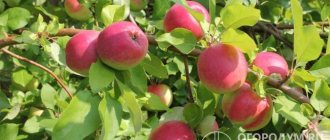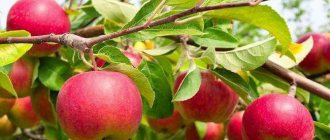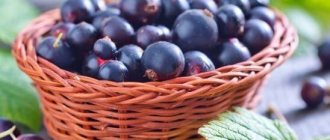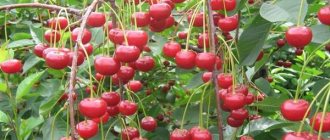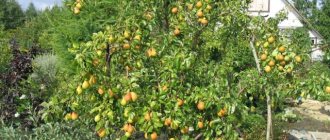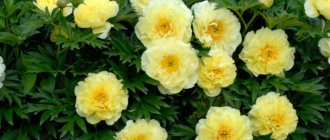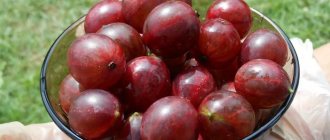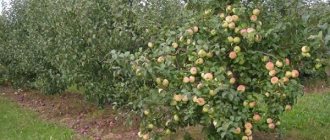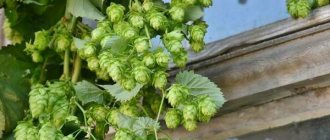Description of the variety
Gooseberry Jubilee was obtained at the All-Russian Research Institute of Horticulture named after. I.V. Michurina by crossing the Bedford yellow and Houghton varieties, entered into the state register in 1965, zoned for the Central Black Earth region.
The plant forms a slightly spreading, vigorous bush with a dense crown of straight spiny stems. Young shoots have a greenish tint, lignified ones: light gray. The spikes are mostly double and triple.
The leaves have a smooth matte surface with blunt short teeth. The shape is five-lobed, pubescence is absent. The leaves are located at an angle of 45˚ to the stems and are attached to them using a long, strong petiole.
The small buds have a flattened shape with oval-rounded sepals and are united into small inflorescences.
Large, round berries weighing up to 5-7 g when ripe are colored red with yellowish tint. They have dense skin, without pubescence, with a slight bluish coating and yellow veining. The pulp is juicy with a rich sour-sweet taste. Tasting score 4.7 points out of 5.0 possible. Chemical composition: total sugars - 9.2%, titratable acidity - 2.0%, ascorbic acid - 11.8-40.0 mg/100 g.
Description of gooseberry Jubilee
Gooseberries are zoned in the Central Black Earth region. The Yubilyar variety is especially popular among gardeners in Siberia, the Moscow region, and the Urals. The plant is grown in the middle zone and in the south.
The photo above shows the gooseberry Jubilee, the description of the variety is as follows:
- Tall shrub, compact, not spreading, formed by numerous shoots. Perennial stems are straight with drooping tops, grow up to 1.8 m long, the bark is smooth, hard, dark gray.
- The shoots of the current year are green, grow quickly, and by autumn the color becomes light brown.
- The thorns of the Jubilee gooseberry are located along the entire length of the perennial stems. Collected in 2 pieces, long, hard, with prickly tops, growing at an angle of 900.
- The leaves are oppositely located, five-lobed, with uneven edges, green. The upper part of the leaf blade is glossy, wavy, and the veins are deep. The lower one has sparse pubescence.
- Small flowers, cone-shaped, green with an anthocyanin fragment at the base, collected in 1-2 pieces. at a leaf node.
- The berries are smooth with a thin waxy film, oval in shape, weight - 5-6.5 g.
- The peel is thin, durable, pink with a dark burgundy fragment on the side on which the berry is located towards the sun, with longitudinal light stripes.
- The pulp is yellow, with numerous brown seeds.
- The root system is mixed, the central part is deepened by 45-60 cm.
Gooseberry Jubilee produces flowers of different sexes, the plant is self-pollinating. Fruiting is stable, independent of weather conditions.
Advice! Crops of the Russian and Kolobok varieties planted nearby will increase the productivity of Yubilyar gooseberries by 35%.
Drought resistance, frost resistance
The drought resistance of the Yubilyar variety is low; lack of moisture affects the growth of gooseberries. Productivity drops, berries lose weight and elasticity, and acid dominates the taste. If there is insufficient seasonal rainfall, gooseberries of the Yubilyar variety need watering.
Gooseberry Yubilyar occupies a leading position among cultivars in terms of frost resistance. The plant resists temperatures down to -320 C; if shoots are damaged during the growing season, it completely restores the crown. If flowering occurs at the time of returning spring frosts, the flowers are preserved at a temperature of -50 C; this feature is a priority when choosing a variety for gardeners in temperate climates.
Fruiting, productivity
The crop produces single berries in the second year of the growing season, reaching its peak yield after 4 years of growth. Gooseberries of the Yubilyar variety belong to the average ripening period. The shrub blooms in the second half of May. The fruits reach biological ripeness at the same time. The harvest is harvested at the end of July. Fruiting is stable, with timely watering and fertilizing with 1 unit. take up to 5-6 kg.
The berries of the Yubilyar variety are firmly attached to the stalk; after ripening, the fruits remain on the bush for a long time. Gooseberries are not prone to shedding and baking in the sun. At low temperatures and excess moisture, cracking of the berries is possible.
The taste characteristics of the variety’s berries according to a 5-point tasting system are estimated at 4.8 points. The berries are sweet, juicy, not cloying, the acid concentration is insignificant. Gooseberry Jubilee is universal in use. It is used to make fruit puree, jam or preserves. Consumed fresh, the fruits completely retain their chemical composition and taste after freezing.
The peel of the fruit of the variety is thin, but durable, and resists mechanical damage during transportation or mechanized harvesting. Gooseberry Jubilee is suitable for cultivation on farms and for commercial purposes.
Important! The harvested crop is stored at a temperature of +180 C and 85% air humidity for 7 days without loss of density and weight.
Advantages and disadvantages
Jubilee gooseberries have been grown for more than 50 years throughout almost the entire territory of the Russian Federation. The variety owes its popularity to a number of advantages:
- stable, high fruiting;
- optimal frost resistance for the crop;
- transportability, long shelf life;
- berries with good taste, do not bake and do not fall off after ripening;
- resistance to viral and fungal infections, the variety is rarely affected by anthracnose;
- easy to propagate, 100% rooted on the site;
- long fruiting period - 15-18 years;
- simple agricultural technology.
The disadvantages of the Jubilee gooseberry include the presence of thorns and average drought resistance.
Brief description (pros, cons)
Gooseberry Jubilee is one of the popular plants cultivated in household plots and gardens. This is explained by the inherent advantages of the variety.
Advantages of the variety
- good winter hardiness;
- high yield. Average figures vary from 4 to 8.5 kg. from each bush (14 t/ha);
- average resistance to powdery mildew and anthracnose;
- high survival rate of seedlings;
- self-fertility;
- stable fruiting, peak yield in the fifth year of the plant’s life;
- good marketability and taste characteristics of the fruit, the berries do not lose their shape during transportation;
- versatility. Jubilee berries are valued as a product for fresh consumption. They can also be frozen and used to make aromatic jam, delicious preserves, refreshing fruit drinks and compotes;
- possibility of mechanized collection. This characteristic is due to the straight stems with low thorniness.
The Yubilyar variety has practically no disadvantages. Some gardeners consider it a disadvantage that the largest number of berries are formed on branches older than five years, but this feature applies to most varieties. The obvious disadvantages include a large number of thorns, which makes caring for the crop difficult.
Cultural information
Gooseberry is a berry bush that represents the not too extensive family Grossulariaceae (Gooseberries). Depending on the variety, the plant can grow from 0.6 m to 1.5 m or 2 m. There are weakly branched and highly branched bushes. They are all perennials. Average life expectancy is 15-30 years. During this period, the crop produces tasty berries. They are oval, spherical or oval-round in shape. Types of fruit colors:
Gooseberry Jubilee
- Burgundy;
- White with a light green note;
- Light emerald;
- Yellow.
The crop is grown for harvest or as a hedge to decorate the site. Berries have beneficial properties. In particular, due to the high content of ascorbic acid (more than in some citrus fruits) and pectin substances, they improve immunity and fight heavy metal poisoning.
Additional Information . The fruits help with ailments of the bladder and kidneys. The delicacy has a beneficial effect on metabolic processes, etc.
All members of the family some time ago were divided into two large blocks:
- Classic;
- New and hybrid.
Classic - time-tested varieties. These are thorny shrubs with not too much frost resistance. They are especially demanding of the gardener's attention. At the same time, the growth in mileage is weak. According to reviews, berries from classic bushes are the sweetest.
Breeders were able to develop new and hybrid plants based on North American berry varieties. They are more unpretentious, have good immunity, and begin active growth immediately after planting. These varieties include the Jubilee gooseberry.
Landing
For Jubilee gooseberries, it is recommended to choose a well-lit place. A good option is to place it on the south side of the fence, which will protect the plant from gusts of wind.
The site should be located on a hill with deep groundwater. This will protect the root system from rotting. When planting, we must not forget that the Jubilee gooseberry does not develop well on acidic soils. If you have acidic soil, then you need to add ash, lime (100 g/m2) or dolomite flour (200 g/m2) to it. The structure of the soil can be either sandy loam or clay, the main thing is that it is fertile.
Seedlings are purchased with strong shoots and an elastic root system without signs of drying or rotting. Immediately before planting, they are kept for a day in a solution of a drug that stimulates root formation, for example, in Kornevin or Zircon.
The area is dug up and cleared of weeds. Planting holes are prepared with a depth and a diameter of about 50 cm. The distance between bushes is sufficient to maintain 1.0 m, since the bushes are formed from straight, non-thorny shoots, the distance between rows is 2.0-2.5 m.
The soil removed from the hole is combined with a bucket of humus and enriched with a mineral complex in accordance with the instructions. Add a glass of ash. Place the seedling in the center of the hole, making sure that the roots lie freely and do not bend. The hole is filled with soil substrate. Each layer is carefully compacted. The root collar should be deepened by 5 cm. Deepening the root collar stimulates the growth of new replacement shoots. The seedlings are watered abundantly, the tree trunk circle is mulched with a layer of 5-7 cm. The stems are cut, leaving 4-6 buds.
Briefly about gooseberries
Gooseberry Jubilee: photo
Gooseberry is a member of the Gooseberry family and is a perennial berry bush. The height of gooseberry bushes ranges from 60 to 200 cm, and the crown can be branched to varying degrees - from very dense to sparse. The lifespan of these plants is from 15 to 30 years, most of this time they bring a rich harvest. Gooseberries have the shape of an ellipse, oval or slightly flattened ball. Their color has many shades, which include such primary colors as yellow, green, dark red, there is also a white gooseberry with greenish veins.
The purpose of gooseberries is not limited to food purposes - often its bushes are planted in garden plots for the purpose of landscaping and decorating the landscape, and hedges are formed from them. The berries of this crop are a valuable source of large amounts of vitamins, for example, ascorbic acid, the percentage of which in these berries exceeds its content in the fruits of citrus plants. In addition, gooseberries are rich in pectin and other beneficial substances; eating them helps improve immunity, helps overcome the effects of heavy metal poisoning, reduces the adverse effects of external factors on the body, speeds up metabolism, and has a healing effect on the genitourinary system.
Not long ago, all varieties of gooseberries were divided into two broad groups. The first includes classic varieties that have been known for a long time and have characteristics traditional for a given culture. As a rule, these are shrubs protected by thorns that require regular care, do not tolerate winter frosts well, and the growth rate of their shoots is not fast. Meanwhile, it is the classic gooseberry varieties that bear the sweetest berries. The second group includes new varieties and hybrids bred on the basis of gooseberry varieties that came from North America. They are distinguished by their unpretentious nature, good tolerance of low temperatures, and a short adaptation period when transplanted to a new location. The variety "Yubilyar" belongs specifically to this group.
History of selection of the variety “Yubilyar”:
The gooseberry variety “Jubiler” was born thanks to the efforts of Chelyabinsk breeders, who obtained it as a result of crossing two varieties - “Bedford Yellow” and “Houghton”. Scientists set themselves the task of combining the best characteristics of both varieties, so the new variety is superior to its parents in many respects.
Growing and care
Gooseberry Jubilee is an unpretentious crop. But to ensure decent productivity, it needs to be provided with regular care.
Watering
In warm, dry weather, the Jubilee is watered at the rate of a bucket of water once every 10 days. Particular attention is paid to the fruiting period, when the soil should not be allowed to dry out too much. Watering is carried out in the evening or in the morning at the root. Sprinkling is not used. In the sun, it can lead to burns and also provoke the development of fungal diseases.
In rainy summers, the Yubilyar variety does not require additional moisture. They regularly loosen, weed, and renew the layer of mulch, which retards evaporation and prevents the germination of weeds.
Trimming
The Jubilee bushes are thinned starting at the age of three. Pruning is carried out in early spring. Remove dry, broken, frozen branches. The event is repeated in the fall after the leaves fall.
In adult plants, old stems older than 7 years are cut flush to the ground. Remove excess growth. In total, the bush should contain no more than 20 shoots of different ages.
Top dressing
For the first two years after planting, the gooseberry needs enough nutrients added to the hole during planting. Starting from the age of three, the Jubilee will need regular feeding.
To grow green mass, nitrogen is needed, so in early spring, pour a bucket of water with urea dissolved in it under each plant - 2 tbsp. l. Before flowering and during fruit set, use a mineral complex, diluting 3 tbsp. l. for 10 liters.
Preparing for winter
Gooseberry Jubilee tolerates a drop in winter temperature to -30˚C without damage.
Given this feature, in the fall, adult bushes are not additionally covered. To prevent the roots from being damaged, especially if there is insufficient snow cover, the bushes are hilled. Dry peat or humus is placed in the tree trunk circle.
Features of cultivation
One of the main factors that will have a direct impact on the yield of the plant is the purchase of high-quality planting material. Seedlings can be sold with an open root system and with a closed one (in containers).
When purchasing bare-root planting material, pay attention to the following points:
- Age - 2 years.
- The appearance of the plant itself is 2-3 strong shoots, at least 25 cm long, without foliage, with unopened axillary buds, without signs of dryness or mechanical damage. The coloring should be uniform.
- The rhizome is powerful, woody, 20–25 cm long, consisting of several main stem shoots and many additional ones.
Saplings with an open root system should be purchased immediately before planting. It is permissible to store such planting material after transportation for no more than 3 days.
We suggest you learn how to make a bush holder for gooseberries.
When buying seedlings in pots, you should evaluate the following characteristics:
- Age - 1 or 2 years. This parameter is not particularly important in such cases, since vegetation can be kept in a container as long as you like, the main thing is to moisten the soil in time.
- The foliage is abundant, the leaf blades themselves are soft green, evenly colored.
- The length of the shoots is 30 cm for annuals, from 40 to 50 cm for biennials.
- Rhizome - if you remove the top layer of soil, there should be a large number of white roots underneath. There should be no exposed main roots on the surface of the earthen coma. Otherwise, it is better to refuse the purchase, because the plant has been in the pot for too long, which will adversely affect its level of adaptation.
- The plant should sit tightly in the pot - if the seedling is easily shaken out of the container, it means that the roots did not have time to entwine the earthen ball, and this indicates that it was transplanted immediately before sale.
Selecting a location
The terrain on the site must be selected taking into account humidity and lighting. The ideal option would be the southern or southeastern part of the territory, not flooded by groundwater (the optimal distance to groundwater is 2 m).
There are no special requirements regarding soil. However, higher yields are observed on well-drained, light, loose soils with a slightly acidic reaction. Soil preparation on the site is carried out 6 months before planting and consists of the following:
- deep digging to a depth of 40 cm;
- adding 10 kg of compost, 10 kg of manure and 10 kg of sand per m²;
- re-digging.
Planting and care, pollination
Planting is carried out in the fall, around mid-September or in the spring before the buds open. It is best to plant plants in the spring - this will allow you to observe the process of adaptation to a new place and immediately correct errors if any. Before carrying out the manipulation, the shoots are cut to 30 cm. Then they are powdered with wood ash and the root system is immersed in the Kornevin solution (1 teaspoon of powder per 1 liter of water) for 12 hours.
Important! Peat can be used as mulch instead of compost.
Step by step planting process:
- Dig a hole 65 cm deep, 55 cm in diameter. Form depressions in the soil according to a pattern of 1.5 × 1.5 m.
- Place 15 cm of gravel at the bottom of the hole.
- Mix all the soil from the pit with 5 kg of humus, 5 kg of compost and 5 kg of peat. For every 10 kg of the resulting soil mixture, add 4 tbsp. l. nitrophoska, 2.5 tbsp. wood ash and 60 g agricola.
- Place the nutrient composition in a 15 cm layer on a gravel drainage pad.
- Place the plant in the center of the hole - level it so that after filling the hole with soil, the root collar is buried 6 cm.
- Fill the hole with soil and compact lightly.
- Pour 10 liters of water. Wait until moisture is absorbed, mulch the soil around the bush with compost (5 cm layer).
This crop does not need pollinators, because it is self-fertile. However, if you plant Kolobok and Russky varieties nearby, the yield can be increased by 35%. During June–July, plantings are actively moistened every 3–5 days, depending on weather conditions. 10 liters of liquid are added to each bush. In the fall, in mid-September, moisture-recharging irrigation is carried out, during which 20 liters of water are applied to each m² of plantings.
We suggest that you familiarize yourself with information about what kind of soil gooseberries like.
Fertilizing is carried out during the swelling phase of the buds and in mid-September. In the spring, a manure solution is used - add 1 liter of mullein to 10 liters of water. This amount is enough to feed one plant. In the fall, 24 hours after water-recharging irrigation, apply 1 tbsp per m². l. superphosphate, 20 g of potassium salt. Fertilizers are buried 10 cm into the soil.
After each watering or rain, it is necessary to thoroughly loosen the soil - this will help avoid its cracking in extreme heat, and also ensure uniform distribution of the liquid.
Video: How to plant gooseberries correctly
Disease and pest control
Resistance to diseases and pests is one of the most positive aspects of the crop in question. However, when air and soil humidity increases, as well as when agricultural practices are violated, the bushes may suffer from powdery mildew. Before starting treatment, remove all infected parts of the plants, and then treat them with Topaz if the plant is not yet bearing fruit, or Fitoverm if the bushes have already formed berries.
Therapeutic agents are diluted according to the instructions. To prevent powdery mildew at the end of the season, after harvesting the leaves, treat with a 1% solution of colloidal sulfur. Among the pests, gooseberry caterpillars can settle on the bushes of the variety in question. To get rid of them, you can dust the leaves and soil with wood ash or tobacco dust.
Pruning and shaping the bush
The first pruning is carried out before planting. A year later, 3–4 strong buds are left on each shoot. On average, annual growths at this stage are shortened by 1/4 of the length. All branches that thicken the crown grow inside the bush and are cut into a ring.
In the second year, new shoots are shortened by 1/3. Zero ones, i.e. those that grow from the root, are removed completely. Do the same with growths that thicken the crown.
In the third year after planting, they follow the same scheme as in previous years. After each pruning, all cuts must be treated with wood ash and covered with garden varnish to avoid infection.
Important! Formative pruning is carried out before sap flow begins in the spring.
From the 8th year of life of the shrub, anti-aging pruning begins on the site, otherwise the yield will be greatly reduced. The purpose of this manipulation is to activate the growth of zero shoots. To do this, in the fall, over the course of three years, 1/3 of all branches are cut to zero.
Zero growths that grow over the season are shortened by 1/4 in the fall. For rejuvenation, you can use another pruning option - shorten all shoots of the bush to 15 cm. In subsequent years, in this case, formative pruning is carried out according to the above scheme.
Wintering
The crop in question is characterized by an increased level of winter hardiness. Shelter is not required even in frosty winters with little snow.
Reproduction
Gooseberries are easily propagated by vegetative methods. In May, a strong two-year-old shoot is selected and carefully laid horizontally in a shallow groove. Soil is poured on top. By autumn, several seedlings appear, from which the strongest ones with developed roots are selected for replanting.
The second method is to propagate gooseberries using green cuttings. In June, cuttings with developed buds are cut - at least six. They are planted in a loose soil substrate and covered with film. Roots begin to develop within a month. It is important not to forget to regularly moisten the soil.
Features of reproduction
The Jubilee variety is propagated only vegetatively - by cuttings or layering. Layers are obtained in the following way:
- cuts are made on one or more branches located close to the ground;
- dig a shallow hole;
- they lower a branch into it and fall asleep;
- Water during the season and do not allow the soil to dry out.
By autumn, roots will form in the cut; for the winter, the cuttings are insulated. In the spring, the rooted sections are cut with pruning shears and planted. This method is considered the fastest and most optimal.
Cuttings are prepared in early June from woody perennial branches or last year's stems. They retreat from the top by 40-50 cm, take cuttings 20-25 cm long. The cut is treated with a manganese solution and placed in a fertile substrate.
In the spring, the material will form leaves and sprout shoots; in the fall it can be planted. As an example, the photo below shows a gooseberry seedling, Jubilee, grown independently from cuttings. Planting material with sufficient green mass and a formed root system is completely ready for placement on the site.
Reviews
Not the best variety in terms of thorns. By the time you reap the harvest, your hands will scratch and bleed. Now there are many varieties either practically without thorns, or with a minimal amount of them on the lower part of the shoots, take the same popular Grushenka. It looks like I will uproot the hero of the day.
I consider Yubilyar the best gooseberry variety. It combines the best qualities: excellent taste, winter hardiness, resistance to powdery mildew. The bushes are powerful, beautiful, productive, and can be used as a hedge.
Gooseberries of the Jubilee variety are not yet widely known, although they undoubtedly deserve it. The tasty large fruits and high winter hardiness of the plant attract attention.
Reviews from gardeners
Gardeners liked the hero of the day, which is confirmed by their positive reviews.
Raisa, Volgograd region: “I have 3 varieties of gooseberries growing on my plot, among them there is Yubilyar. I like it because no matter what the weather is, I am sure that I will pick 5-6 kg of berries from the bush. Caring for the bushes is minimal; they have never gotten sick the entire time. Perhaps this is because I spray the bushes with colloidal sulfur every year in the spring. The only negative for me is a lot of large and sharp thorns.”
Vasily, Novosibirsk: “The Yubilyar variety is literally created for cultivation in Siberia - thanks to its excellent frost resistance, it grows well in cold climates. My bushes are planted in lowlands, covered on both sides with earthen elevations so that they are not damaged by the wind. So I do without additional shelter and water the bushes less often than recommended, because water flows into the lowlands. The variety bears fruit every year, the harvest is rich, the berries are delicious.”
Advantages and disadvantages
Giving preference in cultivation to one or another gooseberry variety, you need, first of all, to dwell in more detail on its pros and cons. Taking into account the weaknesses of the plant will allow you to better organize its care.
- The main advantages of Masheka gooseberries:
- high winter hardiness;
- excellent indicators of quantity and quality of fruits;
- versatility of crop application, possibility of transportation over long distances;
- decorativeness of bushes;
- high resistance to diseases and pests;
- self-pollinating.
- Disadvantages of Masheka:
- too much root growth;
- demands on lighting;
- intolerance to waterlogging of the soil - the plants begin to hurt.
Drought resistance, frost resistance
This crop is a drought-resistant plant - abundant watering is required only in the initial phases of the growing season (spring and early summer). It also shows high resistance to frost - it tolerates temperature drops down to -31°C. The vegetation is not susceptible to pests and diseases if cultivation practices are followed.
Productivity and fruiting
The bushes begin to bear fruit 3-4 years after planting. From one bush you can harvest 5-6 kg of high-quality fruits with a sweet and sour taste every year. With proper care, the bushes can consistently produce fruit for 16–20 years.
Important! To prolong the ability of a crop to produce a harvest, it is necessary to rejuvenate the bush every 6–8 years by pruning. Otherwise, the vegetation will stop producing berries by the age of 8–10 years. Main characteristics of berries:
Main characteristics of berries:
- titratable acidity 2.23%;
- sugar content 9.5%;
- dry matter 14.5%;
- ascorbic acid 36.5 mg/100 g;
- pectins 0.89%;
- phenolic components 330.5 mg/100 g.
Gooseberry Jubilee: variety description, photos, reviews, planting and care
Detailed description of the gooseberry variety Jubilee: large, yellow-red fruits weighing up to 6.5 g, medium ripening, with excellent (4.7 points) taste, resistant to.
Features of planting and cultivation.
1. General information about gooseberries. Useful properties of gooseberries.
Gooseberries contain a lot of micro- and macroelements (phosphorus, potassium, sodium, magnesium, iron), tannins, organic acids and pectin, carotene, vitamins A, B, PP, and in terms of vitamin C content, gooseberries can only compete with currants. The beneficial properties of gooseberries are such that it has a choleretic, laxative and diuretic effect, in combination with honey it is recommended for anemia, hypertension and obesity, skin diseases, frequent hemorrhages, diseases of the teeth and gums, it frees the human body from toxins, radionuclides and salts heavy metals, strengthens blood vessels. Another benefit of gooseberries is that it lowers cholesterol, stimulates cellular metabolism, and simply gives strength and vigor.
2. Choosing a place for gooseberries.
– Gooseberries require a well-lit place. Otherwise, the sugar content of the berries may decrease and the overall yield will decrease.
– Gooseberries should be planted along fences or other hedges. A little wind protection will not harm it, especially on the north side.
– Gooseberries do not tolerate stagnant water. If there is a possibility of flooding of the bush in the area, drainage should be done if possible. Otherwise, the shrub will have poor development or even its death.
– Gooseberries require light, slightly acidic soil (pH 6-6.5) or neutral, medium and slightly podzolized, loamy and sandy loam soils.
3. Planting red gooseberries and care.
– Gooseberry seedlings should be buried 5-8 cm when planted in the ground.
– The branches of a young gooseberry seedling are cut off by one third.
– Gooseberries do not require mandatory cross-pollination, however, the yield from cross-pollination (the presence of two or more different varieties) increases, the berries become larger and have a better taste.
– The feeding area of one gooseberry bush is 1-2 sq.m. The distance between two neighboring bushes is 1-1.5 meters.
– For many gooseberry varieties it is necessary to provide branch support.
– Gooseberries should be fed in the spring. When planting, you should add organic fertilizer (horse humus or humus), from mineral nutrition you can take 70-80 g of double superphosphate, 30-40 g of potassium sulfate or 100 g of wood ash.
– Watering gooseberries should be done 2-3 times a week at the rate of one bucket of water per adult bush, twice a day (in the morning and in the evening). Good watering is very important in the period July-August, when fruiting occurs, and at the same time flower buds are laid on the bushes, forming the next year's harvest. If there is a severe lack of moisture during this period, crop losses are possible both in the current and next year. Gooseberries are a relatively drought-resistant crop due to their deeper root system than, for example, currants.
– Gooseberry is a frost-resistant crop. However, in order to protect the bush from early frosts and snowless winters, it is recommended to mulch with horse humus in the area around the tree trunk.
4. Pruning gooseberries.
With proper pruning, you can not only increase the yield of the bush and the size of the berries, but also save it from diseases.
– When planting, the branches of a young gooseberry seedling are cut by half to two-thirds. This will help him bush faster.
– Pruning of gooseberries should be done in early spring before the buds open (usually the month of April), or in late autumn before frost, after harvesting.
– Pruning of branches is carried out close to the ground - stumps should not be left.
– It is necessary to remove the oldest (over 10-12 years old) and diseased shoots.
– Branches with berries that grow close to the ground and even lie on it should be removed.
– It is necessary to periodically thin out the bush to increase the yield and prevent the appearance of diseases and pests.
– Of the young shoots, only a few strong ones should be left. Weak and crooked ones should be removed.
– If you want to tidy up an old bush (rejuvenate it), then start cutting out a few of the oldest shoots every year. You cannot take and cut off too many shoots at once, as this will be a very big shock for the shrub.
– A properly pruned bush should have 2-3 branches of each age (2 one-year-olds, 2 two-year-olds, 2 ten-year-olds). Total approximately 15-20 branches.
Description of the variety Jubilee
Where to buy gooseberries in Moscow? Which gooseberry is best to plant in the Moscow region? Which gooseberry variety is the most delicious? We will help you find the answer to these and other questions! Just call or come to our nursery!
Diseases and pests
The variety is resistant to powdery mildew. However, there are other diseases that are dangerous to the crop. Among them:
- septoria (brown spots up to 3 mm in diameter appear on the leaves, which later turn white);
- anthracnose (leaf blades become covered with red spots, which grow and merge as the disease progresses).
To treat these two fungal diseases, use a 3% solution of copper sulfate or a 3% solution of Bordeaux mixture.
We also recommend reading how to deal with lichen and moss on gooseberries.
Plants can also be affected by parasites:
- gooseberry moth;
- glassware;
- yellow sawfly;
- spider mite;
- gooseberry aphid.
Pests are removed with insecticides. The drug Karbofos has proven itself to be effective in treating all of these parasites.
Not only a professional farmer, but also a simple summer resident can cope with growing the Yarovoy variety. The shrub will decorate the garden plot and will certainly please the owner with a delicious ripe harvest.
Description of culture
Gooseberry represents a bush that bears fruit. Gooseberry is part of the not very large family of Gooseberries. The bushes of the crop differ in properties, this will depend on the variety, for example: the bushes can be spreading, highly branched.
The culture is perennial; depending on the variety, care, and conditions, the life expectancy of gooseberries can be from fifteen to thirty years.
Gooseberry varieties can differ in shape and color of the berries; the shape can be oval, spherical, oval-round, and the color can be burgundy, pale green, light emerald, yellow.
All types of culture are divided into two groups: classic, new hybrid.
New hybrid varieties of gooseberries bred according to the North American model. They do not require special care, have excellent immunity, and shoots grow quickly. Another plus is thornlessness. The hero of the day is one of these.
